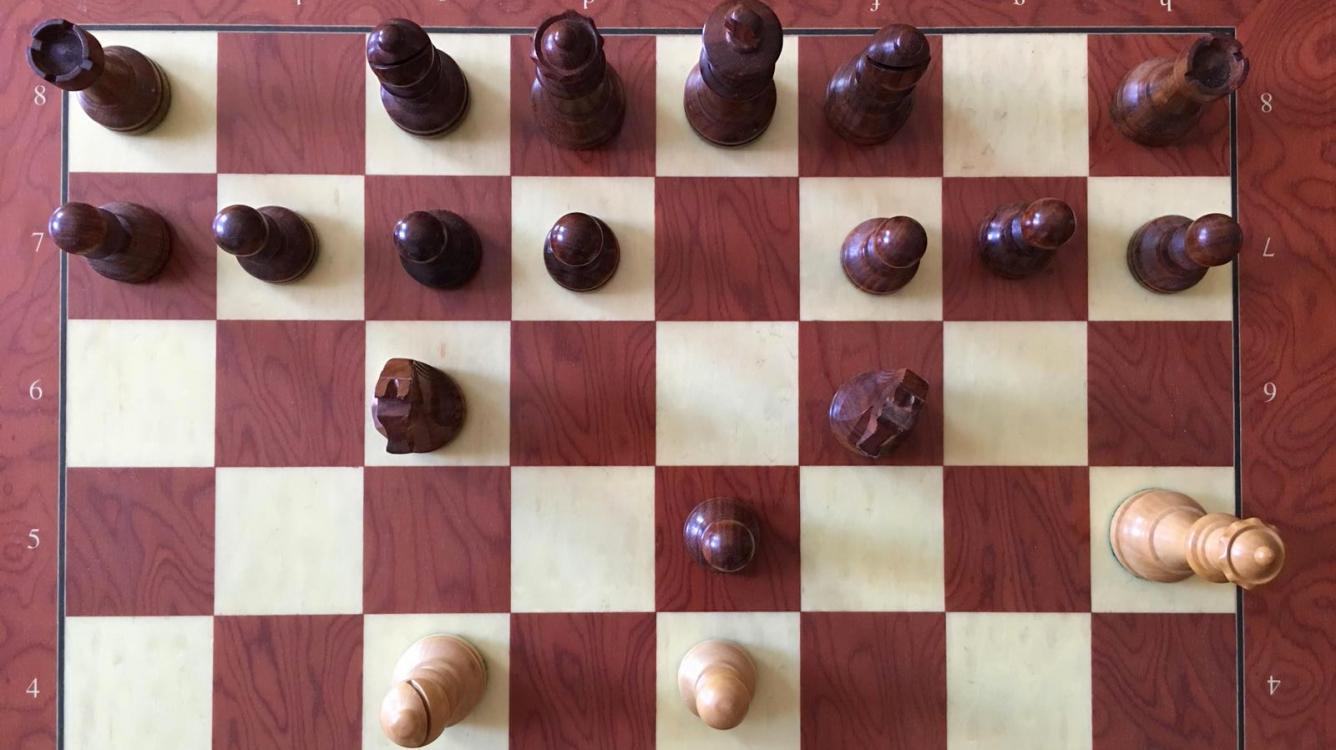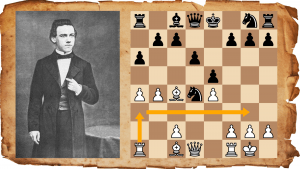
Attacking f7: The Good, The Bad, The Ugly
What's the weakest spot on the chessboard? Surely it must be the f7 square.
Only protected by the black king, the poor pawn on f7 has been a classic victim of tricks and attacks. It's fair to say chess players have been obsessed with f7 since the dawn of modern chess.
The French manuscript Le Jeu des Eschés de la Dame, moralisé, dated around 1500, describes a game played between the devil as White, and a lady (whose soul is at stake) playing with the black pieces.

Satan tries his luck with 1.e4 e5 2.Qh5, perhaps hoping for a quick scholar's mate.
Instead, the Evil One lost his queen after 2...g6 3.Bc4?? gxh5 and the lady won the game. (The scholar's mate, by the way, was first described as such by Jo Barbier in 1640.)
Over the centuries, numerous ways have been tried to profit from the weakness of the f7 square early in the opening. Here are a few that are quite familiar:
The next one, from the Petroff Defense, is much more positional:
And here's a lesser-known but still very interesting variation from the Alekhine Defence:
By the way, don't be mistaken in thinking this kind of stuff only happened in the 18th and 19th centuries! Here's the start of a game played recently at the super-GM tournament in Dortmund:

An old line with Nxf7 in the recent Dortmund game Kovalev-Kramnik. | Photo: Georgios Souleidis.
The above lines are all considered to be more or less correct (albeit some of them are speculative) for both sides, so we can safely call them "the good."
However, there are also less effective ways of attacking f7. Weak chess players sometimes seem obsessed by attacking f7, and it's only fitting to come back once more to the game between the devil and the lady. The quality of this game has been described by chess historians as hardly praiseworthy: Murray (1913) saw it as "the worst played I have ever seen recorded" and Eales (1985) called it "so bad as to raise serious doubts about [the devil's] diabolical status".
It's therefore interesting that the same opening was also employed a few times by none other than young Hikaru Nakamura (who was already a very strong player by then):
That must have been a youthful provocation on Hikaru's part, no doubt, but the following is a rather more serious opening variation, arising from the Hungarian Defense. It's a little confusing and it always makes me wonder who's tricking who?
And this article wouldn't be complete without mentioning one of the most famous opening traps of all time: Légal's Mate, named after the French player Sire de Légal (1702-1792):
Then there's a whole bunch of variations where White tries to draw out the black king very early on in the game—as early as move three or four. I remember that as a kid, I was once preparing for an opponent who used to play the Alekhine Defense. I thought for a moment that I had found a nice and new way of playing against that opening—until I looked up the refutation:
A similar line in which taking on f7 is not as dangerous as it looks arises after 1.e4 e5 2.Nf3 Nc6 3.Bc4 Nf6 4.Nc3?! Nxe4. Now White can take on f7 with 5.Bxf7+ but after 5...Kxf7 6.Nxe4 d5 7.Neg5+ Kg8. Black is doing more than fine.
Although these lines are not really incorrect, I would still like to call all of them the bad, as the attack on f7 doesn't result in the desired outcome. (Euwe, in his famous Practical Chess Lessons series, was one of the first authors to make a systematic inventory of the various types of sacrifices on f7.)
But it can always get worse, so we now come to the section of the ugly. And yes, it can get ugly, folks!
Forget simply incorrect attacks on f7, such as the Lolli Gambit (1.e4 e5 2.f4 exf4 3.Nf3 g5 4.Bc4 g4 5.Bxf7+?). Forget almost fake-looking games like 1.d4 d5 (yes, invasions on f7 also happen in the closed games from time to time!) 2.c4 dxc4 3.e4 e5 4.Nf3 Bg4 5.Bc4 exd4?? 6.Bxf7+! (this occurred in an actual game between two great names in chess history: Von Heydebrand und der Lasa vs. Von Bilguer, Berlin 1837).
Instead, take a look instead at the following ridiculous variation, which was in fact analyzed at great length in Polerio's Boncompagno Manuscript no.2 (dated around 1590):
Similarly artificial is the following move sequence, also from Polerio:
But all these odd lines pale in comparison with a really twisted, laughable "variation" I learned not from an old manuscript or book, but from an old chess computer program I had in the 1980's (I think it was called Sargon Chess). The following is a line it used to play sometimes with White—I have no idea why!
Was this a programmer's joke, entering a nonsense variation into its opening book? Who knows. Even computers do weird things sometimes! In any case, it stands in a rich tradition that started more than 500 years ago.
Will we ever overcome our obsession with the square f7? The only cure might be Chess960!






